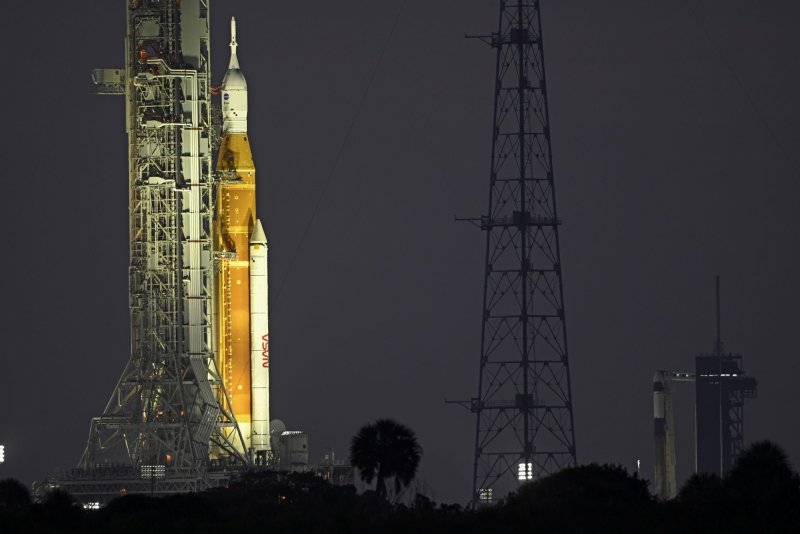1 of 5 | NASA's SLS booster, at left on Pad B, at the Kennedy Space Center in Florida last week, is undergoing tests for its Artemis 1 launch on Tuesday. The "wet dress rehearsal" has been plagued with delays, most recently a valve failure that officials are working around to complete testing. Photo by Joe Marino/UPI |
License Photo
ORLANDO, Fla., April 11 (UPI) -- NASA on Tuesday plans to proceed with modified pre-launch tests of its next mega moon rocket, the Space Launch System.
The tests have been delayed due to a valve issue with the rocket's upper stage, agency officials said Monday, but they will be working around it -- by not fully fueling the rocket -- in order to finish the tests.
Issues with the rocket's helium pressure system -- specifically a faulty valve -- first cropped up during a previous attempt at completing the wet dress rehearsal, forcing officials to delay and ultimately modify the test.
"The vehicle is in really good condition, and it's doing everything we're asking it to do, except for this one issue," John Blevins, SLS chief engineer at NASA's Marshall Spaceflight Center told UPI.
"The modified wet dress rehearsal will [still] let us test a majority of our objectives. It's much more than just a tanking [or fueling] test."
Originally planned for April 3, the wet dress rehearsal is a run-through of launch day activities, culminating in fueling of the rocket, to gather data and make sure both the rocket and ground systems are operating properly.
Multiple delays have continued pushing the test back, with engineers now hoping to wrap it up on April 14.
The faulty valve is part of the rocket's upper stage, called the interim cryogenic propulsion stage, or ICPS. Built by United Launch Alliance, the stage is a modified version of the same upper stage flown on ULA's current heavy-lift rocket, the Delta IV Heavy.
The stage is powered by an RL10 engine, built by Aerojet Rocketdyne, and according to Blevins, the affected valve is a part of the ICPS but is not in the engine itself.
"It's about 3-inches long, and easy to get to," Blevins said. "It's not really accessible on the launch pad, but when we roll back to the VAB, we should be able to reach it and see why it failed."
The valve is part of the upper stage's helium pressure system, which is used to help keep the rocket's upper stage pressurized during fueling and draining. To that end, the team will only focus on loading propellant into the core stage, which is the largest component of the SLS rocket.
The valve is just the latest in a series of glitches that have plagued the wet dress rehearsal, delaying it by more than a week. NASA officials said, however, that they can still achieve the main objectives of the test even if it's modified.
"The teams have worked through a number of challenges so far, and have handled each issue with grace under pressure," Mike Sarafin, Artemis mission manager at NASA, told UPI.
"This test is designed to prepare us for Artemis 1, which is an uncrewed test flight that will set us up for a crewed test flight around the moon with Artemis 2," he said.
Sarafin said that he and the rest of the SLS leadership believe the test can meet its main objectives with without fully fueling the upper stage.
"Loading and draining the core stage is a big part of our test," Charlie Blackwell-Thompson, launch director for the mission, also said during a news briefing. "But we're also testing out operations to make sure we can run through the count and operate necessary launch day procedures in the day provided."
"We need to finish the test on Thursday, and look at the performance of the vehicle," Blackwell-Thompson said. "The data will tell us how to proceed next."
Blevins didn't want to speculate on what caused the valve to fail, but says it will be a straightforward fix if it needs to be replaced. Engineers will know more after Thursday's test is complete and the vehicle is back in the vehicle assembly building.
Currently teams are targeting a launch date sometime between June 6 to 16, but said they may need to start looking at the next window, which is in July, based on where they're at now.















